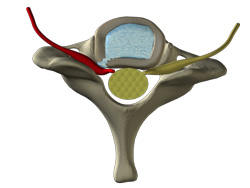Introduction
Ruptured Disc! Herniated Disc! Extruded Disc! Oh my. You flinch at the sound of these terms because you have experienced the pain or know someone who has. The appropriate term for these types of herniated discs is "non-contained disc."

Description
The non-contained disc may cause neck but usually pain into the extremities (one or both arms). This disc condition causes you pain because its nucleus pulposus (the center of the disc) has escaped through tears in the anulus fibrosus (the outer layers of the disc) and found itself in the spinal canal where it isn’t supposed to be. The anulus fibrosus no longer contains the nucleus pulposus.
The non-contained disc irritates the spinal nerves with a chemical reaction or with pressure. Normally, the nucleus pulposus' fluid has never been in the spinal canal, and when it does enter, it causes a chemical reaction around the nerve to cause pain. The nucleus pulposus' fluid chemically irritates the spinal nerves just by its mere presence in the canal, and, if enough of it escapes into the canal, its mass presses on spinal nerves causing pain into the arm.
Watch this description of a non-contained disc herniation on xray.
Examination
A thorough, clinical examination that may include imaging is important to your recovery.
Cervical Spine Exam Description
Treatment
In-office, Wilson Family Chiropractic use Cox Technic Flexion Distraction and Decompression to lower the pressure in the disc and aid in the absorption of the free nuclear material that is irritating the nerve. Cox Technic also aids in the healing of the torn anular fibers and drives out chemicals that irritate and inflame the spinal nerves.
Graphic Animation of Cox Technic - Cervical Spine
The disc is pressing on the nerve. Note that as the disc herniation reduces, the pinched nerve is relieved.
This is an animation of the goal of Cox Technic
Flexion-Distraction and Decompression: reduced irritation of spinal elements
enough to relieve pain and help you regain your quality of life. The amount of
decrease in size of the herniated disc necessary for pain relief varies from 0%
to 100% for each individual patient.
Cox Technic Protocol I - for pain that extends below the elbow
Cox Technic Protocol II - for pain that is in the neck and stays above the elbow
You must understand that it takes three months for a torn disc to heal well enough to allow you to return to daily activities like prolonged ironing or talking on the phone, etc. The first three to four weeks of concentrated treatment, therapies, and at-home care are designed to allow the best opportunity for the disc to heal quickly. This three month window does not mean that you must be treated continually throughout this time period, but means that you must be cautious and aware of your spine's healing. Recognize that even though the pain is gone, healing is still taking place and could be hindered if you do something to aggravate the process.
At Home Care
At home you will want to avoid sleeping on your stomach, wear a neck brace if recommended, take nutritional supplements that help rebuild disc cartilage, exercise, and modify your daily activities as needed. You will want to work closely with your doctor to ensure your treatment is properly administered and your return to maximum health is maximized.
Exercise Tips
Exercise is important to your recovery and prevention of future pain.
It is important to start exercises as soon as possible, not vigorously, but gently.
Do only exercises recommended.
Do exercises only to your tolerance.
Clinical Case Reports
Contact Wilson Family Chiropractic for an evaluation and treatment plan for relief of your cervical spine non-contained disc herniation.